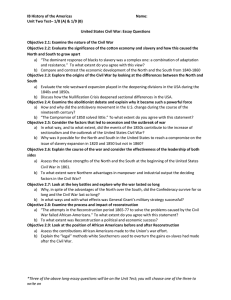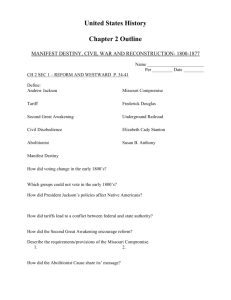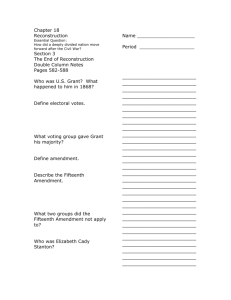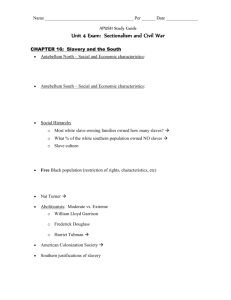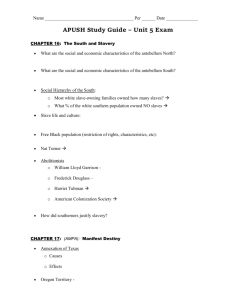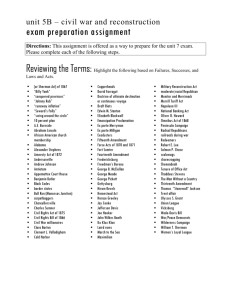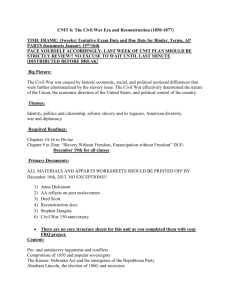Chapter 14 Reading Guide – Use these terms and questions to
advertisement
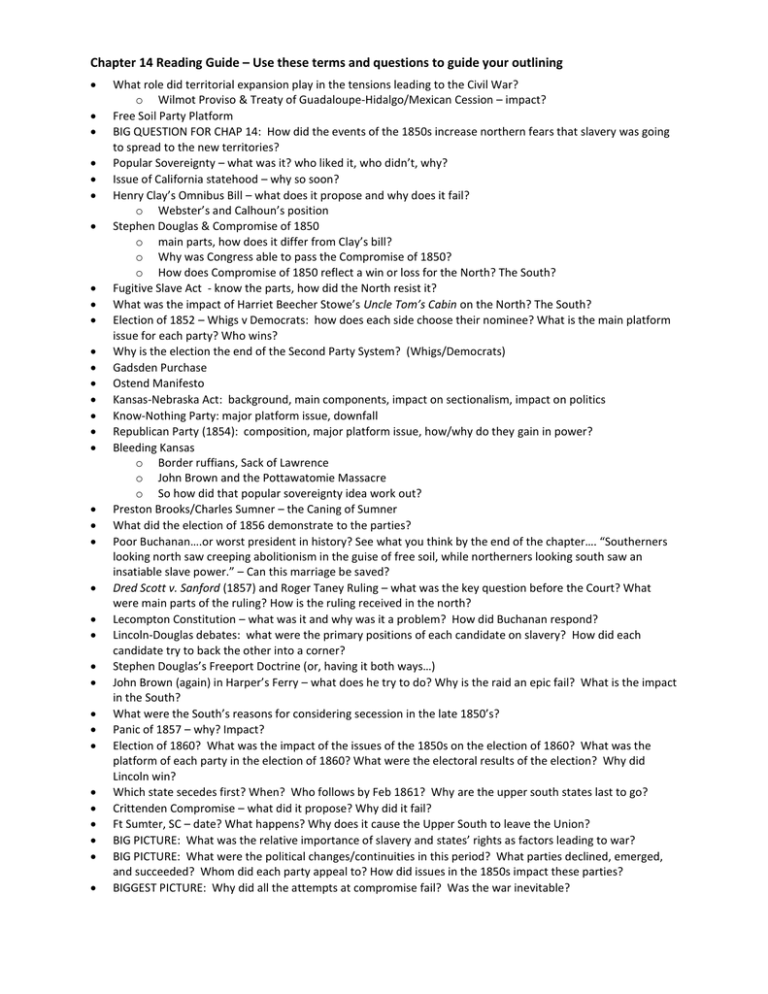
Chapter 14 Reading Guide – Use these terms and questions to guide your outlining What role did territorial expansion play in the tensions leading to the Civil War? o Wilmot Proviso & Treaty of Guadaloupe-Hidalgo/Mexican Cession – impact? Free Soil Party Platform BIG QUESTION FOR CHAP 14: How did the events of the 1850s increase northern fears that slavery was going to spread to the new territories? Popular Sovereignty – what was it? who liked it, who didn’t, why? Issue of California statehood – why so soon? Henry Clay’s Omnibus Bill – what does it propose and why does it fail? o Webster’s and Calhoun’s position Stephen Douglas & Compromise of 1850 o main parts, how does it differ from Clay’s bill? o Why was Congress able to pass the Compromise of 1850? o How does Compromise of 1850 reflect a win or loss for the North? The South? Fugitive Slave Act - know the parts, how did the North resist it? What was the impact of Harriet Beecher Stowe’s Uncle Tom’s Cabin on the North? The South? Election of 1852 – Whigs v Democrats: how does each side choose their nominee? What is the main platform issue for each party? Who wins? Why is the election the end of the Second Party System? (Whigs/Democrats) Gadsden Purchase Ostend Manifesto Kansas-Nebraska Act: background, main components, impact on sectionalism, impact on politics Know-Nothing Party: major platform issue, downfall Republican Party (1854): composition, major platform issue, how/why do they gain in power? Bleeding Kansas o Border ruffians, Sack of Lawrence o John Brown and the Pottawatomie Massacre o So how did that popular sovereignty idea work out? Preston Brooks/Charles Sumner – the Caning of Sumner What did the election of 1856 demonstrate to the parties? Poor Buchanan….or worst president in history? See what you think by the end of the chapter…. “Southerners looking north saw creeping abolitionism in the guise of free soil, while northerners looking south saw an insatiable slave power.” – Can this marriage be saved? Dred Scott v. Sanford (1857) and Roger Taney Ruling – what was the key question before the Court? What were main parts of the ruling? How is the ruling received in the north? Lecompton Constitution – what was it and why was it a problem? How did Buchanan respond? Lincoln-Douglas debates: what were the primary positions of each candidate on slavery? How did each candidate try to back the other into a corner? Stephen Douglas’s Freeport Doctrine (or, having it both ways…) John Brown (again) in Harper’s Ferry – what does he try to do? Why is the raid an epic fail? What is the impact in the South? What were the South’s reasons for considering secession in the late 1850’s? Panic of 1857 – why? Impact? Election of 1860? What was the impact of the issues of the 1850s on the election of 1860? What was the platform of each party in the election of 1860? What were the electoral results of the election? Why did Lincoln win? Which state secedes first? When? Who follows by Feb 1861? Why are the upper south states last to go? Crittenden Compromise – what did it propose? Why did it fail? Ft Sumter, SC – date? What happens? Why does it cause the Upper South to leave the Union? BIG PICTURE: What was the relative importance of slavery and states’ rights as factors leading to war? BIG PICTURE: What were the political changes/continuities in this period? What parties declined, emerged, and succeeded? Whom did each party appeal to? How did issues in the 1850s impact these parties? BIGGEST PICTURE: Why did all the attempts at compromise fail? Was the war inevitable? 5.3.I - The North’s greater manpower and industrial resources, its leadership, and the decision for emancipation eventually led to the Union military victory over the Confederac in the devastating Civil War. 1.) Place the following events in order, analyzing the importance of each on the course of the war. a. Vicksburg, Antietam, Gettysburg, Appomatox Courthouse, March to the Sea, First Battle of Bull Run 2.) Compare and contrast Northern and Southern advantages and disadvantages during the Civil War, and explain how those advantages eventually lead to a northern victory 3.) Evaluate home-front opposition to the Civil War, both in the North and the South 4.) Analyze the impact of the Emancipation Proclmation on the course, as well as the purpose, of the Civil War a. European support, black troops, northern support, Lincoln’s evolving motives 1. What were the relative advantages and disadvantages of each side at the start of the war? 2. How did these strengths and weaknesses determine the strategy that each side took to fight the war? 3. What legislation did the Republican Party pass that was unrelated to the war? 4. How did this legislation impact the nation’s expansion westward? 5. How did each side finance the war? 6. What means did each side pursue in seeking foreign allies? 7. Why did the Confederacy’s hope for European allies not materialize? CHAPTER 21 1. What were the key turning points in the war? 2. What did the Emancipation Proclamation do and not do for the slave population of the South? 3. How did blacks contribute to the war effort? 4. How did each side curtail the rights of individual private citizens? 5. What impact did the war have on people’s daily lives during the war? 6. In what ways did women contribute to the war effort? 7. In what ways did the North’s goals in fighting the war change during the war? CHAPTER 22 1. Explain what happened in the first Congressional elections after the war. 2. Describe the efforts of former slaves to control their own lives and the results. 3. Which two bills did Johnson veto and why? What was the reaction of Congress? 4. What was in the 14th 5. What happened during the Congressional elections of 1866? 6. What were the issues in Johnson’s impeachment and why did it fail? 7. What was the reaction of the women’s movement to the 15th 8. Make a list describing Radical Reconstruction in the South. 9. Describe the sharecropping system. 10. Describe the Counterrevolution to Congressional Reconstruction. 11. How did the Grant administration’s approach to Reconstruction doom Reconstruction? 12. What happened during the election of 1876? 13. Why did Reconstruction come to an end? Amendment and why did Congress pass it? Amendment? Themes Concept Questions Beliefs, Ideas, and Cultures America in the World How was the American conflict over slavery part of larger global events? Geography and Environment Peopling How did the growth of mass migration to the United States and the railroad affect settlement Identity How did migration to the United States change popular ideas of American Identity and Politics and Power Why did attempts at compromise before the war fail to prevent the conflict? To what extent, Economics – Work, Exchange & Technology How did the doctrine of Manifest Destiny affect debates over territorial expansionism and the Mexican War? How did the Civil War struggle shape Americans’ beliefs about equality, democracy, and national destiny? How did the end of slavery and technological and military developments transform the environment and settlement patterns in the South and the West? patterns in cities and the West? citizenship as well as regional and racial identities? How did the conflicts that led to the Civil War change popular ideas about national, regional, and racial identities throughout this period? and in what ways, did the Civil War and Reconstruction transform American political and social relationships? How did the maturing of northern manufacturing and the adherence of the South to an agricultural economy change the national economic system by 1877? 1. 2. 3. Answer the following questions fully and completely. List the states that succeeded. Who didn’t and what were they called? What happened with West Virginia? Create a T-chart comparing the North and South in terms their preparedness to fight the Civil War. Be sure to include transportation/infrastructure systems, population numbers, and supply/technology access. Explain the war plans of the North (The Anaconda Plan) and South (Defensive Plan). Be specific and thorough. 4. 5. 6. 7. Create a graphic organizer comparing the Northern and Southern leaders of the war. Include the following leaders in your graphic organizer: A. Lincoln, G. Meade, G. McClellan, A. Burnside, J. Hooker, U. Grant, W. Sherman for the North, J. Davis, R. Lee, T. “Stonewall” Jackson in the South. Be sure to address the role, weaknesses, and strengths of each leader. Complete the chart on the major battles of the Civil War. Battle/Event Details Where? Leaders Outcome involved Who won and why? Fort Sumter First Bull run Peninsula Campaign Merrimack/Monitor Antietam Gettysburg Vicksburg Sherman’s March Appomattox What impact did the Emancipation Proclamation have on the war effort? Be specific and include the 13 th amendment in your response. Fill in the following graphic organizer about the political and economic stresses of the war using the terms below. Be sure to explain these terms in context of the impact on politics or the economy Morrill Tariff Act Greenbacks - National Banking System Homestead Act US Sanitary Act The Fall of Cotton King Trent affair 13th Amendment Congressional Committee on the Conduct of the War The Man without a Country Election of 1864 Political activity Economic activity Evaluation the impact on the war outcome North South 8. How did the Civil War impact civil liberties? Be sure to include the suspension of the writ of Habeas Corpus, the Copperheads, conscription/draft, the New York draft riots, and Andersonville, GA in your response. 9. What role did women, American Indians, and blacks play in the war? Give at least one specific example for each category. 10. Tell the story of the assassination of Abe Lincoln. Be sure to include the who, what, when, where, why, and significance. 11. How was America forever changed at the end of the Civil War? Include the social, economic, and political state of America immediately after the end of the war. 12. In one concise sentence, summarize “The Problems of Peace.” 13. Describe the Freedman’s experience. Be specific. Use pages 466-469 to answer this question. 14. Create a Triple Venn diagram comparing the following plans for Reconstruction: Lincoln’s 10% Plan, the WadeDavis Plan, and Johnson’s Plan. Under the Venn, answer the following question: What differences did these plan illustrate between the executive and legislative branches’ view on Reconstruction 15. How did congress and President Johnson clash during early reconstruction? Be sure to address the Pacific Railroad Act, the Civil Rights Bill, and the 14th amendment in your response. 16. Who were the Radical Republicans and what impact did they have on Reconstruction? Be sure to address Thaddeus Stevens, the Reconstruction Act, and the 15th amendment in your response. 17. Create a T chart comparing how Reconstruction affected southerners? Be sure to address the impact on freed blacks (the Union, League, Black Codes, the Ku Klux, Klan) and whites (Scalawags, Carpetbaggers, Force Acts) in your comparison. 18. What role did the Office of Tenure Act play in Johnson’s presidency? 19. In one concise sentence, summarize “The Heritage of Reconstruction.”
